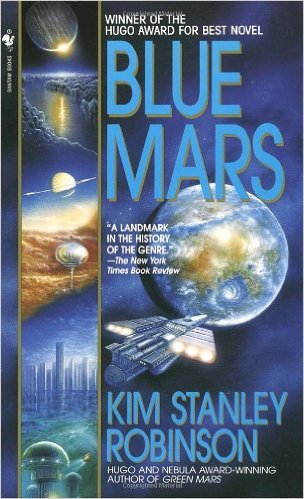
One of the most enthralling science fiction sagas ever written, Kim Stanley Robinson’s epic trilogy concludes with Blue Mars—a triumph of prodigious research and visionary storytelling.
The red planet is no more. Now green and verdant, Mars has been dramatically altered from a desolate world into one where humans can flourish. The First Hundred settlers are being pulled into a fierce new struggle between the Reds, a group devoted to preserving Mars in its desert state, and the Green “terraformers.” Meanwhile, Earth is in peril. A great flood threatens an already overcrowded and polluted planet. With Mars the last hope for the human race, the inhabitants of the red planet are heading toward a population explosion—or interplanetary war.
Praise for Blue Mars
“A breakthrough even from [Robinson’s] own consistently high levels of achievement.”—The New York Times Book Review
“Exhilarating . . . a complex and deeply engaging dramatization of humanity’s future.”—The Philadelphia Inquirer
“[Blue Mars] brings the epic to a rousing conclusion.”—San Francisco Chronicle
Quotes and thoughts while reading:
These were a good series of books, that really made Mars feel real. They were fully fleshed out - but in that - they were a bit too long. Each of these three books I wanted to end, about 300 pages before they did. All in all, it's a great epic series of science fiction.
..."Well, some of it we're going already, designing structures that spread the power around, and diminish the dangers of majoritarianism. Decentralization is important, because it created a lot of small local majorities. Another strategy is to set up an array of Madisonian checks and balances, so that the government's a kind of cat's cradle of competing forces. This is called polyarchy, spreading power around to as many groups as you can."
"Maybe we're a bit too polyarchic right now," Art said.
"Perhaps. Another tactic is to deprofessionalize governing. You make some big part of the government a public obligation, like jury duty, and then draft ordinary citizens in a lottery, to serve for a short time. They get professional staff help, but make the decisions themselves."
"I've never heard of that one," Nadia said.
"No. It's been often proposed, but seldom enacted. But I think it's really worth considering. it tends to make power as much a burden as an advantage. You get a letter in the mail; oh no; you're drafted to do two years in congress. It's a drag, but on the other hand it's a kind of distinction too, a chance to add something to the public discourse. Citizen government."
"I like that," Nadia said.
"Another method to reduce majoritarianism is voting by some version of the Australian ballot, where voters vote for two or more candidates in ranked fashion, first choice, second choice, third choice. Candidates get some points for being second or third choice, so to win elections they have to appeal outside their own group. It tends to push politiains toward moderation, and in the long run it can create trust among groups, where none existed before."
"Interesting." Nadia exclaimed. "Like trusses in a wall."(p 139)
"In any case, Charlottes metahistory was very influential, providing for the explosively accelerating diaspora a kind of master narrative, by which they could orient themselves; and so she joined the small list of historians whose analyses had affected the flow of their own time, people like Plato, Plutarch, Bacon, Gibbon, Chamfort, Carlyle, Emerson, Marx, Spengler and on Mars before Charlotte, Michel Duval. People now ordinarily understood capitalism to have been the clash of feudalism and democracy, and the present to be the democratic age, the clash of capitalism and harmony. And they also understood that their own era could still become anything else as well Charlotte was insistent that there was no such thing as historical determinism, but only peoples repeated efforts to enact their hopes; then the analysts retroactive recognition of such hopes as came true created an illusion of determinism. Anything could have happened; they could have fallen apart into general anarchy, they could have become a universal police state to control the crisis years; but as the great metanationals of Terra had in reality all mutated into Praxis-like worker-owned cooperatives, with people in control of their own work democracy it was, for the moment. They had enacted that hope.
And now their democratic civilization was accomplishing something that the previous system could never have accomplished, which was simply survival in the hypermalthusian period. Now they could begin to see that fundamental shift in systems, in this twenty-second century they were enacting; they had shifted the balance, in order to survive the new conditions. In the cooperative democratic economy, everyone saw the stakes were high; everyone felt responsible for their collective fate; and everyone benefited from the frenetic burst of coordinated construction that was going on everywhere in the solar system.
This flowering civilization included not only the solar system beyond Mars, but the inner planets as well. In the flush of energy and confidence humanity was working back in to areas previously considered uninhabitable, and now Venus was attracting a crowd of new terraformers, who were following up on the gesture made by Sax Russell with the relocation ofMarss great mirrors, and had elaborated a grand vision for the eventual inhabitation of that planet, the sister to Earth in so many ways.
And even Mercury had its settlement. Although it had to be admitted that for most purposes, Mercury was too close to the sun. Its day lasted fifty-nine Terran days, its year eighty-eight Terran days, so that three of its days equaled two years, a pattern that was not a coincidence but a node on the way to being tidally locked, like Luna around the Earth. The combination of these two spins gave Mercury a very slow roll through its solar day, during which the brightside hemisphere became much too hot, while the nightside hemisphere became extremely cold. The lone city currently on the planet was therefore a kind of enormous train, running around the planet on tracks set on the northern forty-fifth latitude. These tracks were made of a metalloceramic alloy that was the first of the Mercurial physicists many alchemical tricks, a matrix that withstood the eight-hundred-K heat of midbrightside. The city itself, called Terminator, then ran over these tracks at a speed of about three kilometers per hour, which kept it within the planets terminator, the zone of predawn shadow that was in most terrain about twenty kilometers wide. A slight expansion of the tracks exposed to the morning sun farther to the east drove the city ever westward, as it rested on tightly fitting sleeves shaped to slide the city away from the expansion. This motion was so inexorable that resistance to it in another part of the sleeves generated great amounts of electrical power, as did the solar collectors trailing the city, and set on the very top of the high Dawn Wall, catching the first blasting rays of sunlight. Even in a civilization where energy was cheap, Mercury was amazingly blessed. And so it joined the worlds farther out, and became one of the brightest of all. And a hundred new floating worlds opened every year cities in flight, little city-states, each with its own charter, settler mix, landscape, style."(p 484)
<< click to go back
© JKloor Books
